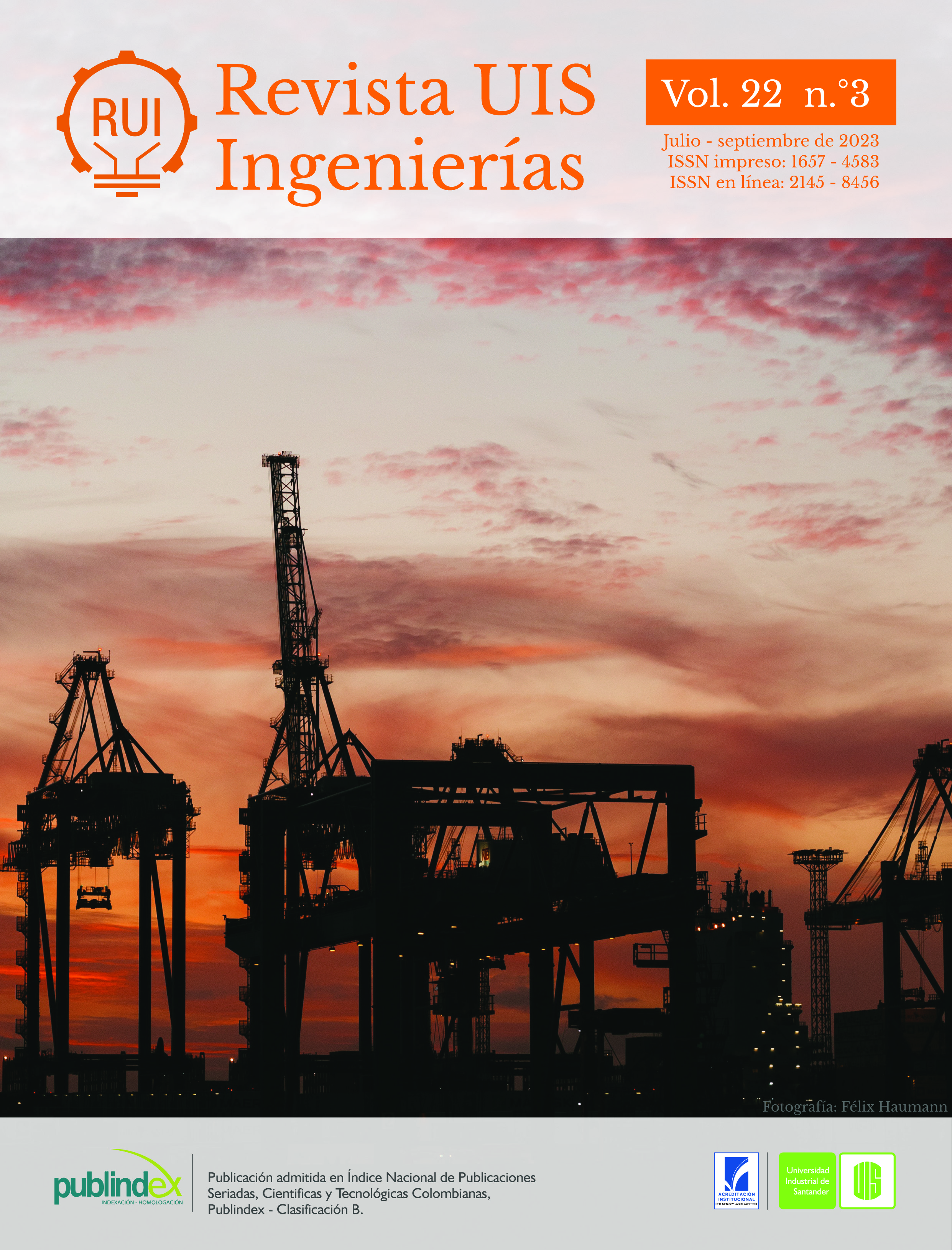Inmersive Learning of the Raw Sugar Cane Labors. Design Thinking applied to Virtual Reality Design
Published 2023-06-17
Keywords
- design thinking,
- interactive design,
- cultural heritage,
- virtual reality
How to Cite
Copyright (c) 2023 Revista UIS Ingenierías

This work is licensed under a Creative Commons Attribution-NoDerivatives 4.0 International License.
Abstract
This study investigates how Design Thinking can be applied in the design of a virtual reality application for teaching the cultivation and production of panela as a strategy for preserving intangible cultural heritage. A user-centered design process was carried out to develop an intuitive and easy-to-use application. The results of the study showed that the focus on Design Thinking significantly improved the effectiveness of the application in learning and preservation of heritage. Additionally, the prototypes received a high usability rating from the participants. In conclusion, it was demonstrated that Design Thinking is a valuable tool for the development of educational virtual reality applications and strategies for preserving intangible cultural heritage. The current study research how design thinking could be applied to the design of a virtual reality application focused to the teaching of farming and production of raw sugar cane as a strategy for historical immaterial heritage conservation. A design process was taken focused on the user, with the goal of developing an application that is intuitive and easy to use that helps preserving the culture and traditional knowledge related to raw sugar cane. The results of the study showed that the design thinking usage significantly improved the efficiency of the application in the learning of the participants and the preserving of the historical immaterial knowledge. In addition, the prototypes got a high assessment on usability from the participants. In conclusion, it was shown that the design thinking is a valuable tool for the development of virtual reality educative applications and strategies for the preservation of historical immaterial heritage.
Downloads
References
- H. J. A. Cobos Viviescas, M. F. Gonzalez Breton, “Aplicación de Realidad Virtual (VR) enfocada a la experiencia interactiva del proceso de la panela, vinculado al proyecto de investigación para la innovación de museografía enfocada en el rescate del patrimonio histórico y cultural de los oficios: Caso componente interactivo del Centro de Interpretación de la Panela y la Caña.” trabajo de grado, Universidad Industrial de Santander, 2022.
- D. Benyon and A. Resmini, “User Experience in Cross-channel Ecosystems,” Proceedings of the 31st International BCS Human Computer Interaction Conference 2017, doi: http://dx.doi.org/10.14236/ewic/HCI2017.38
- J. Carroll, Human-Computer Interaction in the New Millennium. 2001.
- F. Vegas Molina, “Herramientas para el diseño de producción en videoclip 360 como modelo ante la necesidad de un producto audiovisual más inmersivo,” Rev. Comun. la SEECI, no. 54, pp. 65–92, 2021, doi: https://doi.org/10.15198/seeci.2021.54.e720
- M. Arias Chaves, “La ingeniería de requerimientos y su importancia en el desarrollo de proyectos de software,” InterSedes Rev. las Sedes Reg., vol. 6, pp. 1–13, 2005.
- A. Iñiguez Carrillo, M. Garcia-Ruiz, “Evaluación de Usabilidad de un Ambiente Virtual en 3D,” Rev. Faz, vol. 3, pp. 56–67, 2009.
- G. Peralta Domínguez and P. C. Santana-Mancilla, “Mejorando la experiencia del turismo cultural con un prototipo de realidad virtual,” Rev. Comput. Sci., vol. 76, pp. 111–122, 2014.
- M. S. Ortega and P. B. Ceballos, Design thinking: Lidera el presente. Crea el futuro. Esic editorial, 2015.
- C. Latorre-Cosculluela et al., “Design Thinking: creatividad y pensamiento crítico en la universidad,” Rev. electrónica Investig. Educ., vol. 22, pp. 1–13, 2020, doi: http://dx.doi.org/10.24320/REDIE.2020.22.E28.2917
- P. Fuchs, G. Moreau, P. Guitton, Virtual reality: Concepts and technologies. Taylor & Francis Group, 2011.
- M. S. Stickdorn, J. Schneider, This Is Service Design Thinking: Basics-Tools-Cases. Wiley, 2012.
- S. Clatworthy, “Service design thinking,” in Innovating for Trust. M. Lüders, T. W. Andreassen, S. Clatworthy, and T. Hillestad, Eds. Edward Elgar, pp. 167–182, 2017 doi: https://doi.org/10.4337/9781785369483
- IDEO, “History | IDEO | Design Thinking.” [En línea]. Disponible en: https://designthinking.ideo.com/history
- B. L. V. Márquez, L. A. I. Hanampa, M. G. M. Portilla, “Design Thinking aplicado al Diseño de Experiencia de Usuario,” Innovación y Softw., vol. 2, no. 1, pp. 6–19, 2021, doi: https://doi.org/10.48168/innosoft.s5.a35
- M. Stickdorn, J. Schneider, K. Andrews, A. Lawrence, This is service design thinking: Basics, tools, cases. Wiley Hoboken, 2012.
- C. Fink, “New ShapesXR Revolutionizes XR Development,” Forbes, 2021. [En línea]. Disponible en: https://www.forbes.com/sites/charliefink/2021/11/11/new-shapesxr-revolutionizes-xr-development/?sh=2cea658ea230
- C. Hillmann, “UX and Experience Design: From Screen to 3D Space,” UX XR, pp. 117–155, 2021, doi: https://doi.org/10.1007/978-1-4842-7020-2_4
- H. Cecotti, Z. Day-Scott, L. Huisinga, L. Gordo-Pelaez, “Virtual Reality for Immersive Learning in Art History,” in 2020 6th International Conference of the Immersive Learning Research Network (iLRN), 2020, pp. 16–23. doi: https://doi.org/10.23919/iLRN47897.2020.9155108
- K. Holubchak, “The Application of Design Thinking Methodology in Architectural Education in Ukraine: Case Study,” Archit. Civ. Eng. Environ., vol. 13, no. 4, pp. 19–29, 2020, doi: https://doi.org/10.21307/ACEE-2020-027
- Y. Zhou et al., “VR/AR Technology in Human Anatomy Teaching and Operation Training,” J. Healthc. Eng., vol. 2021, 2021, doi: https://doi.org/10.1155/2021/9998427
- Y. Pulijala, M. Ma, M. Pears, D. Peebles, A. Ayoub, “Effectiveness of Immersive Virtual Reality in Surgical Training—A Randomized Control Trial,” J. Oral Maxillofac. Surg., vol. 76, no. 5, pp. 1065–1072, 2018, doi: https://doi.org/10.1016/J.JOMS.2017.10.002
- R. A. Roberto et al., “Voxar puzzle motion: An innovative ar application proposed using design techniques,” 2016 IEEE Virtual Real. Work. K-12 Embodied Learn. through Virtual Augment. Reality, KELVAR,pp. 11–16, Sep. 2016, doi: https://doi.org/10.1109/KELVAR.2016.7563676
- M. Fischer, “The future of health debates? A design thinking sketch of the VR Health Arena,” Health Technol.,vol. 8, no. 4, pp. 281–290, 2018, doi: https://doi.org/10.1007/S12553-018-0220-Z/TABLES/3
- M. Hincapie, C. Diaz, M. Zapata, C. Mesias, “Methodological framework for the design and development of applications for reactivation of cultural heritage: Case study cisneros marketplace at Medellin, Colombia,” J. Comput. Cult. Herit., vol. 9, pp. 8:2-8:24, 2016, doi: https://doi.org/10.1145/2827856
- R. A. Grier, A. Bangor, P. Kortum, S. C. Peres, “The System Usability Scale: Beyond Standard Usability Testing,” en Proceedings of the Human Factors and Ergonomics Society Annual Meeting, 2013, doi: https://doi.org/10.1177/1541931213571042

